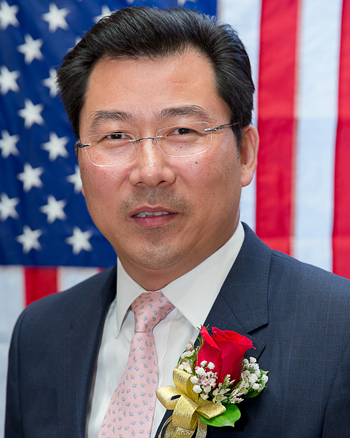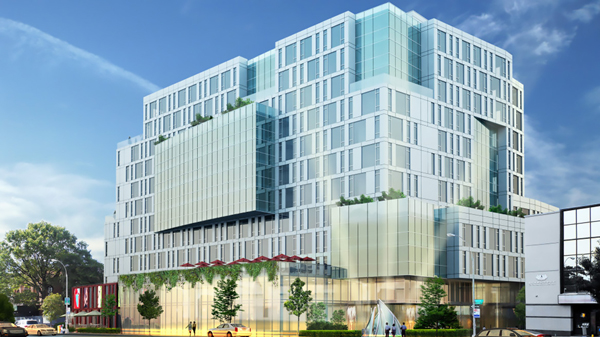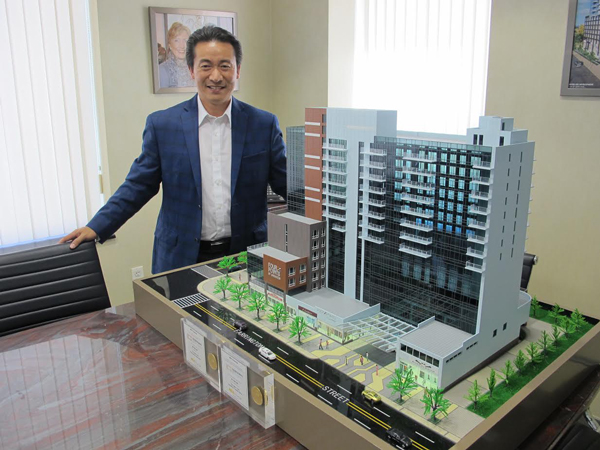UPDATED, 2:51 p.m. June 12: Although George Xu has several ambitious developments in the works in Queens, one of the deals he’s proudest of is one where he didn’t actually do any building.
In 2003, just a few years into his career as a developer, Xu bought 131-02 40th Road in Flushing for about $10 million, financed with a $7 million Bank of China mortgage. The site, where he intended to build a mixed-use property, offered over 500,000 buildable square feet.
“We were going to do three towers over there,” said Xu, whose slicked-back dark hair, stylish blazer and perpetual grin make him seem younger than his 48 years. “And then we’ve got a great view facing Manhattan, facing LaGuardia.”
In 2006, however, Xu turned around and sold the site for $26 million to McSam Hotel Group’s Sam Chang, without commencing construction. The fat profit allowed him to tackle more projects and expand into neighborhoods such as Long Island City.
“I would have to say it’s kind of like a turning point, even though we didn’t develop on it,” Xu said. “But that built the stage for me to build up different pieces of land and set me up for other development.”
Chang didn’t build there either, eventually selling the property for $45 million to Andy Chau’s Wing-Fung Realty in 2015. But Xu isn’t losing sleep over the potential windfall had he held onto it longer.
“I don’t regret the decision,” he said. “We took the money, we went to Long Island City, and we made a lot more money.”
The deal was a key component of what has become one of the most substantial property portfolios in Queens. Through his firm Century Development Group, Xu, a former software developer, controls more than 1 million buildable square feet in emerging markets like Flushing and Long Island City and is looking to bring hundreds of new residential units to market.
One of the Long Island City sites Xu obtained with the 40th Road funds was 38-50 21st Street, which he purchased from Wachovia Development Corporation in 2007 for $13.6 million. He now wants to turn the site into a 360,000-square-foot mixed-use project featuring retail and office space, condos, affordable housing and a community facility.
“You’ve got a whole lot of bigger players already there [in Long Island City],” Xu said, “so we are just along the way catching the wave.”
The project would require a rezoning, and Xu said he would ideally first rent out the site to a national retail tenant for five years to get things set up. However, he already knows who he wants as a partner: his brother Chris Jiashu Xu, co-owner of the site and president of the United Construction and Development Group.

Chris Xu
The two brothers were principals at C&G Empire Realty, where over a decade they developed more than 1 million square feet of projects in Queens, but split up in 2014 to form their own companies. Chris, who did not respond to multiple requests for comment, is now building several projects of his own, including a 79-story tower in Long Island City that will be the tallest skyscraper in Queens.
Although the siblings still work together occasionally, Xu said they have different philosophies when it comes to development. He generally prefers to work on one major project at a time, while his brother is comfortable tackling several at once.
“I don’t want to undertake many major projects at one time because any bigger project, it’s a lot more time consuming,” he said. “The complexity goes way up, and the financing challenges go up.”
“I play it a little bit more safe than him,” Xu continued, noting that Chris “has a lot more tolerance for stress and for undertaking the bigger projects. There’s nothing wrong with that if you can manage it.”
Dean Rosenzweig, who leads a CBRE team focused on retail in the outer boroughs and is working with Xu to find a retail tenant, said that the rent-wait-develop strategy points to Xu’s “level of sophistication, that as we structured our deal, there is going to be the opportunity for them to continue to develop the surrounding parcels and the assemblage down the road.
“He’s always thinking ahead,” Rosenzweig added. “I can tell that, be it five years or five months.”
Building to code
Xu immigrated to the U.S. from China when he was 16, attending high school on the Lower East Side and earning a master’s degree in computer science from NYU. He spent a few years working in software development but switched to real estate development in 1999 at the urging of his brother, Chris.
His first deal was for a plot of land at 33-33 Linden Place in Flushing, where he built an eight-family house. The gratification of seeing a concrete finished product—along with the solid financial returns—got him hooked on his new job almost immediately. Developing properties, it turned out, was far more satisfying than developing software.
“You build something, you see a building that you like, so it’s rewarding in that sense,” Xu said. “Financially, it’s rewarding as well.”
After starting out with smaller residential projects in Flushing, Xu gradually began spreading into nearby neighborhoods like Corona.
“Along the way, when we finish smaller projects, we’re accumulating the funds, and we are able to buy some bigger projects,” he said.

Rendering of Northern Tower (Credit: Raymond Chan Architect)
One such site was the GW supermarket, which will be a $130 million hotel-and-apartment project known as Northern Tower. Slated for completion in 2018, the property at 137-61 Northern Boulevard in Flushing will feature a 250-key Westin hotel, along with 48 condominiums and approximately 19,000 square feet of community and retail space.
Other major projects Xu has planned for Queens include the Farrington, a 100-unit residential, Hotel And Retail Building On 35th Avenue in Flushing where he plans to live, and a 109-unit Residential Building On 88th Avenue in Jamaica. He also has a condo project at 82 Suydam Street in Bushwick and said he is looking forward to developing more in Brooklyn, specifically downtown. Manhattan, too, is in the cards.
“I just did not find a suitable piece there,” Xu said of Manhattan. “Eventually we’re going to find something that I feel is justified to make a move, but right now I have plenty of things to do in Queens.”
Straight flush
Xu’s projects, and those of his peers, mean that Flushing will soon be known for more than the Mets and the U.S. Open.
One of the largest projects in the area is the $1 billion Flushing Commons, a complex that F&T Group is working on with AECOM Capital and Rockefeller Development. It’s slated to bring more than 600 condos across five buildings to the neighborhood by 2021. Developers have been encouraged by the success of Onex Corporation’s Sky View Parc, a 750-unit condo project where prices have hit north of $1,100 per square foot.
Blackstone Group purchased Sky View Parc’s retail mall and parking garage in 2015 for $400 million, and a 29,000-square-foot site at 159-18 Northern Boulevard recently sold for $13 million, setting a record for the neighborhood.
F&T is also working with SCG America on a 34,000-square-foot movie theater in Flushing as part of the massive Tangram project at 133-15 39th Avenue. The development will include a hotel, 300 luxury condos and 80,000 square feet of office space. The company secured a $214.1 million construction loan for it from HSBC Bank in December. And then there’s Xin Development’s redevelopment of the RKO Keith’s Theater at 135-35 Northern Blvd, where asking prices for condos will range between $1,150 and $1,300 per square foot.
Michael Meyer, president of F&T, said Flushing’s rise was linked to the increase in wealth in Asia over the past two decades, to the point where people living in China will now check on news in Flushing ranging from development updates to weather reports.
“It’s really been a beachhead for a lot of Asian immigration and Asian investment, particularly Chinese, predominantly Chinese,” Meyer said. “Other neighborhoods are thriving. I think Flushing more so. The amount of street traffic is extraordinary here.”

Rendering of Flushing Commons (Credit: Conway + Partners via YIMBY)
The number of projects filed in Flushing has skyrocketed over the past few years, rising from four in 2001 to 44 in 2016, barely shy of its peak of 47 in 2014, according to an analysis by The Real Deal. Additionally, the average rent for a one-bedroom apartment has gone up from $1,571 in 2014 to $2,002 in 2016, while average rents for two-bedrooms rose from $2,091 to $2,814 over the same time period, according to Ariel Property Advisors.
Condo prices have shot up as well, more than doubling over the past 10 years. In 2007, condos sold for an average of $314,650, while in 2017, they sold for an average of $636,379, according to Miller Samuel data. Condo sales have also more than doubled, rising from 144 in 2007 to 275 in 2017.
This popularity is not limited to residential condos. Flushing’s commercial condo market has been active as well, with 56 sales last year totaling $79.9 million, according to Ariel Property Advisors.
As of June 1, median condo prices in the neighborhood ranged from $299,000 for a studio to $985,000 for a unit with three or more bedrooms, while median rental prices ranged from $1,675 for a studio to $2,575 for one with three or more bedrooms, according to StreetEasy data. The website listed the average sales price per square foot in the neighborhood at $582.
Dian Yu, president of the Flushing Business Improvement District, said the development that has poured into Flushing over the past five years has largely changed the neighborhood for the better. However, he maintained that the neighborhood’s infrastructure has not kept up, leading to frustrating pedestrian and vehicle traffic downtown.
“We need to develop the entire community as a whole to make sure that our infrastructure can cater to the growth that we’ve experienced,” he said.
Xu now groups Flushing with Williamsburg and Long Island City as a top destination for condo buyers.
The architect on most of Xu’s major projects is Raymond Chan, who said they have worked together for about 10 years.
Chan described Xu as a straightforward person who loves to talk, and he said it is very important to him that they stay friends at the end of each project.
“He’s a very diligent guy, very smart,” Chan said, “and he tries to do good things, so that’s important for us.”
Credit lines
Although Xu said he normally works with large brokerages such as Cushman & Wakefield and CBRE and that many of his investors are based in China, he tends to get his financing from smaller local institutions, such as Maspeth Federal Savings and Loan. The company provided him with a $3 million mortgage in 2013 for 38-50 21st Street and helped finance his State Manor Condominiums at 139-39 35th Avenue in Flushing. They are currently working with him on a project in Jamaica as well.
“I just find that local banks, they know me better,” Xu said. “They know my background and stuff, so it’s easier to deal with some banks when they know about you.”

Renderings of The Farrington (Credit: Raymond Chan Architect)
Xu has also taken out a $1 million mortgage from Asia Bank for the Farrington, a $17.8 million mortgage from Bank of Hope For His Project On 88th Avenue in Jamaica and a $3 million loan from Cathay Bank for his Holiday Inn Express in Woodside, according to property records.
Richard Maher, chief lending officer at Maspeth, said his company has been doing business with Xu for about 20 years, starting out with small family dwellings in Woodside and growing organically from there. He said Xu was particularly good at not overextending himself.
“He built a track record: very good payer, very professional, and he wasn’t pushing for the stars,” Maher said. “Everything he did was measured. It was conservative. They knew what they were doing.”
“We want to maintain a relationship with him,” he added, “as long as these deals are within our comfort zone.”
Despite Xu’s plans to venture into new areas, he still described Flushing as a very deep market that attracts both local and international buyers.
“We started here. We’re going to continue to be here in the future,” he said. “We want to be in the neighborhood, work with the neighborhood to develop.”
(To view more properties owned by George Xu or Century Development Group, click here)
This story was updated to include the latest numbers for Xu’s Northern Tower project.
